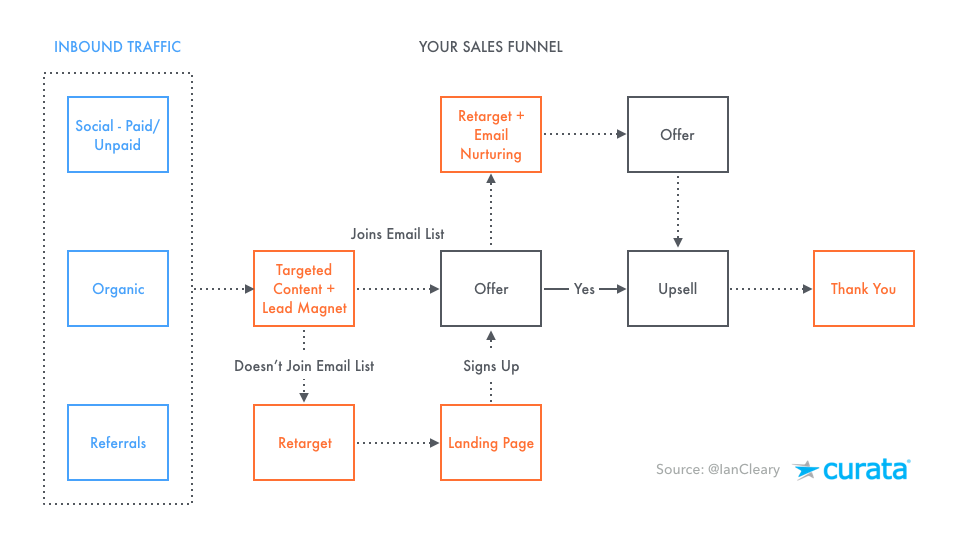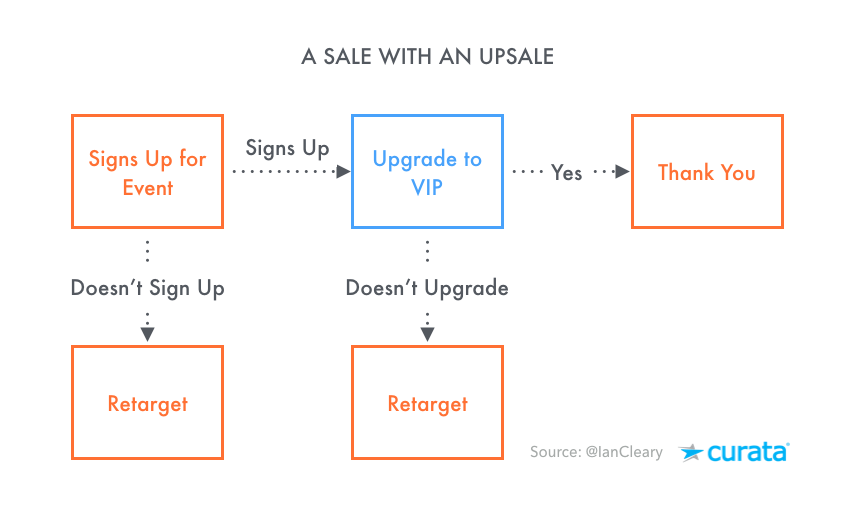- Share Make Sales From Stories With a Content Conversion Funnel on Facebook
- Share Make Sales From Stories With a Content Conversion Funnel on Twitter
- Share Make Sales From Stories With a Content Conversion Funnel on Linkedin
- Share Make Sales From Stories With a Content Conversion Funnel via email
Imagine you have the most amazing product everyone wants to buy—but there’s no way your customers can check out and pay. The same concept applies to your content. Even the best and most engaging content will fall short if your audience can’t easily find it, subscribe to it, share it, and eventually learn about your products or services. That’s exactly what content marketing is about: creating valuable, engaging content that actively paves the way for a sale. How do you create a system to pave the way for a sale? With what’s called a Content Conversion Funnel.
What is a Content Conversion Funnel?
Great content attracts traffic, but it takes a lot of hard work to produce. You certainly don’t want your audience to just leave and never come back, given that nearly every person who lands at your website is a potential customer.
The idea of a Conversion Funnel is that you start with a broad audience at the top of the funnel; all of whom, in theory, could be your customers. As they move down the funnel, the pool of potential customers grows smaller as less likely buyers are weeded out, leaving only those most likely to purchase.
In the end, some convert: they buy your product or pay for your service. Your goal is to have a clear strategy for guiding your prospects through this funnel.
There are different ways to go about this, but the one I’d like to talk about is the PRISM framework. Here’s how it works.
- P for People: First you need an audience. If people aren’t aware of you, everything else is irrelevant. No one will consume your content, subscribe, or purchase your product.
- R for Relationships: We buy from those we trust. A great way to initiate a relationship is to offer your audience value in the form of free, engaging content.
- I for Inbound Traffic: If there’s value, people will come for it. If you share valuable content on social media, people will visit your website where the action takes place.
- S for Subscribers and Social Retargeting: Most people won’t purchase the moment they land at your website, but don’t lose them. Capture their details and stay in touch with email and social media.
- M for Monetization: Once you have subscribers in your funnel you can work to monetize them.
Building a Relationship With Content
This requires first of all, that you produce great content and promote it. Then people discover it, engage with it, and share it with others. There are many ways to build an audience, including advertising, social media, partnerships, PR, and so on.
If you provide someone with value and engage them, that’s typically enough for them to feel at least some kind of relation to you and your brand. People are aware of you; they take you seriously.
If they find your content useful and see there’s no catch, this inspires a level of trust. With enough trust, they’ll give you their email address, or follow you on social media to get more of your content.
This creates a communication channel. Nurture this relationship by providing your audience with more value from consistently engaging content, and keep building trust.
Two things happen from this. First, if you offer value to someone, at some point they’ll want to pay you back. They’ll purchase your product, or at least share your content. Second, as trust grows, they’re more likely to purchase. There’s no reason not to believe your product will be of high value to them if they’ve already gained so much.
But how do you make a sale happen?
Lead Generation Funnel: Get Them to Sign Up
First convert your audience into leads. Then keep building the relationship by offering more value before eventually asking for a sale, such as by offering a free trial or discount to try your product.
There are several ways to convert an audience into leads. One is to use lead magnets. A lead magnet is downloadable content, such as an eBook, report, or content upgrade that you offer in return for an email subscription.
Email remains the most efficient marketing channel there is. According to a study from the UK’s Direct Marketing Association (DMA), email has an average ROI of $38 for each $1 spent. In fact, 20% of companies generate over $70 for each $1 they spend.
Not everyone signs up, but the fact they were on your website and read your content builds brand awareness. Those who don’t sign up are ideal candidates for retargeting.
Retargeting tools like AdRoll, Perfect Audience, or Retargeter—and even Facebook and Google allow you to pixel your audience and target them with ads outside your website. These ads should bring them to your landing page, where you can then convert this audience into leads.
The Webinar Funnel
Webinars are another great way to convert traffic into leads, for two reasons. Firstly, if someone takes time out to watch your content, they’re already highly qualified as a potential customer. Secondly, webinars are personal, and people are more likely to buy from other people.
You can use webinars as lead magnets or market them separately. The key here is that a webinar has to solve a specific problem your customers have that’s related to the same problem your product or service solves.
For example, if your product helps people lose weight, attract the right audience by running a webinar about workout routines or particular forms of dieting.
Webinars shouldn’t be salesy. If people sign up to learn about something, they feel cheated if all they get is your sales pitch. However, absolutely use this opportunity to offer a trial, discount, or to ask them to try your service.
The Sales Funnel: ABC, Always Be Closing
The sales funnel is a different version of a lead capture funnel, and can be used as an extension of a lead capture funnel to convert existing leads.
The diagram below shows how you convert leads and prospects into customers. Some prospects are ready to buy right away, so why not have that option in place?
Ask for a sale, and if they convert—go for an upgrade. If they don’t convert, use retargeting to bring them back.
If they do convert but won’t buy an upgrade, use retargeting again. The simple premise here is that once someone has made a purchase with you, they’re 10 times more likely to buy more. Once they’ve provided you with their personal information and credit card details, trust is already established.
Getting Started: Here’s What You Need
All the above may sound complicated, but remember—building a funnel happens piece by piece. Here’s a simple checklist of skills and resources you and your team need to make it happen.
- Content Creation: Without great content for ads, blogs, videos, or lead-gen guides, there’s no traffic, no brand awareness, no trust, and no leads.
- Content Funnel Optimization: Content marketing isn’t a static practice. With each piece of content you put out, optimize it so you can get more social, organic traffic.
- Content Promotion: If nobody knows about it, nobody will read it. Learn how to build relationships with influencers, how to optimize content for social sharing, what the best time to send your email newsletter is, and so on.
- Advertising: To effectively target your audience, you need knowledge of advertising tools such as Facebook ads, to be able to write great ad copy, and to optimize campaigns for the best possible ROI.
- Social Media: Conversations generate engagement and build relationships. Social media is where to make those conversations happen.
- Conversion Funnel Analytics: No one wants a leaky funnel—and you’ll never know you have one if you don’t measure it.
- Marketing Tools: Knowing which tools are the best fit for your needs gives you an incredible edge. Spend time finding out how to set them up and use them.
- Email Marketing: Nurturing leads requires an email marketing provider. Look for ease of use and analytics when making your choice.
- Payment Provider: To sell, you need to be able to accept payments.
Summary
Every content marketer needs a tight, high functioning conversion funnel. Designing, building and optimizing one requires continuous improvement.
Aside from creating great content, to perfect your conversion funnel requires paying attention, continuously adapting, and being prepared to ask for help. What are your tips for setting up and optimizing a content conversion funnel? Let us know in the comments.










